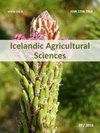青藏高原土壤细菌群落特征因子的焦磷酸测序研究
IF 0.2
4区 农林科学
Q4 AGRICULTURE, MULTIDISCIPLINARY
引用次数: 1
摘要
青藏高原由于其复杂的气候和地形,是地球生态系统中最重要的易受气候和人类活动影响的区域之一。然而,关于QTP环境中土壤细菌群落及其对生态系统的影响的知识仍然很少。本文采用宏基因组学方法对5个主要QTP生态系统(灰褐土、黑钙土、castanozens土、山地草甸土、灰色荒漠土)18个站点的细菌群落结构、多样性及其与环境的关系进行了研究。5种类型土壤的优势菌门均为变形菌门和放线菌门,而灰色荒漠土壤的优势菌门为放线菌门和绿菌门。木薯土和山地草甸土的细菌多样性显著高于其他3种土壤类型(P < 0.05)。灰色荒漠土壤系统发育多样性显著低于其他4种土壤类型(P < 0.05)。种型丰富度在灰褐色土壤中最低。种型丰富度与土壤水分(r = -0.578)和钾元素(r = -0.529)呈极显著相关。系统发育多样性(PD)与总有机碳呈极显著相关(r = -0.548)。冗余分析(RDA)表明,5种土壤类型间细菌群落的多样性和组成差异较大,且与土壤水分、土壤有机碳和土壤钾密切相关。这些结果表明,QTP土壤细菌群落结构受土壤特征和土壤环境特征的明显影响,为QTP土壤生态系统的优化管理和可持续利用提供了理论依据,具有重要意义。本文章由计算机程序翻译,如有差异,请以英文原文为准。
Pyrosequencing investigation into the bacterial communities in the Qinghai-Tibet Plateau soils associated with soil characteristic factors
The Qinghai Tibet Plateau (QTP) is one of the most important regions of the earth’s ecosystem that is vulnerable to climate and human activities due to its complex climate and terrain. However, knowledge about soil bacterial communities and their effect on the ecosystem within the QTP environments is still scarce. Metagenomic approaches on the structure and diversity of bacterial communities and their relationship with the environment from eighteen selected sites of the five major QTP ecosystems (gray-cinnamon soils, chernozems, castanozems, mountain meadow soils, gray desert soils) are presented in this paper. The dominant bacterial phyla in five type soils were Proteobacteria and Actinobacteria, whereas Actinobacteria and Chloroflexi predominated in gray desert soils. The bacteria diversity in castanozeras and mountain meadow soils was significantly higher than that of the other three soil types (P < 0.05). Phylogenetic diversity in gray desert soil was significantly lower than that of other four soil types (P < 0.05). Phylotype richness was the lowest in gray-cinnamon soils. There were significant correlations between the phylotype richness and soil moisture (r = -0.578) and potassium (r = -0.529). Phylogenetic diversity (PD) was significantly correlated with total organic carbon (r = -0.548). The redundancy analysis (RDA) showed that the diversity and composition in the bacterial communities differed greatly among the five soil types and that they were closely correlated with the soil moisture, soil organic carbon and potassium. These results indicated that the bacterial community structures of QTP soils were obviously influenced by soil characteristics and soil environmental characteristics and provided a theoretical basis for the optimal management and sustainable utilization of the QTP soil ecosystem, which is of great significance.
求助全文
通过发布文献求助,成功后即可免费获取论文全文。
去求助
来源期刊

Icelandic Agricultural Sciences
AGRICULTURE, MULTIDISCIPLINARY-
CiteScore
0.80
自引率
0.00%
发文量
0
审稿时长
>12 weeks
期刊介绍:
Icelandic Agricultural Sciences is published annually, or more frequently. The deadline for submitting manuscripts that are intended to appear within that year is September. The journal is in English and is refereed and distributed internationally. It publishes original articles and reviews written by researchers throughout the world on any aspect of applied life sciences that are relevant under boreal, alpine, arctic or subarctic conditions. Relevant subjects include e.g. any kind of environmental research, farming, breeding and diseases of plants and animals, hunting and fisheries, food science, forestry, soil conservation, ecology of managed and natural ecosystems, geothermal ecology, etc.
 求助内容:
求助内容: 应助结果提醒方式:
应助结果提醒方式:


